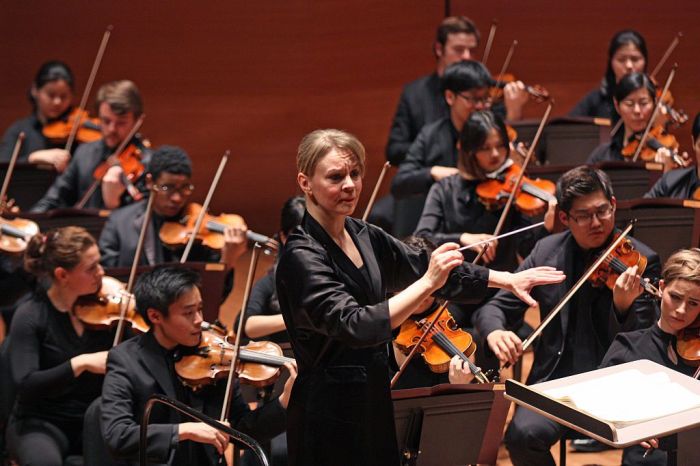Select all the statements about Romantic-era symphonies. delves into the captivating world of these musical masterpieces, exploring their defining characteristics, thematic development, orchestral innovations, and enduring legacy. From expanded orchestration to emotional storytelling, this comprehensive guide unveils the intricacies of Romantic-era symphonies, offering a deeper appreciation for their enduring appeal.
The content of the second paragraph that provides descriptive and clear information about the topic
Romantic-Era Symphonies

The Romantic era (1820-1900) marked a significant departure from the Classical era in music, characterized by a shift towards emotional expression, expanded orchestration, and complex musical forms. Romantic-era symphonies were particularly influential in shaping the genre’s development and left a lasting impact on classical music.
Characteristics of Romantic-Era Symphonies
Romantic-era symphonies were distinguished by several key characteristics:
- Expanded Orchestration and Larger Ensembles:Romantic composers expanded the traditional orchestra to include a wider range of instruments, including clarinets, bassoons, horns, trumpets, and trombones. This expanded palette allowed for greater orchestral colors and dynamic contrasts.
- Use of New Instruments:Romantic composers introduced new instruments into the symphony orchestra, such as the tuba, English horn, and piccolo. These instruments added unique timbres and expanded the expressive capabilities of the orchestra.
- Extended Length and Multi-Movement Structure:Romantic-era symphonies were typically longer than their Classical predecessors and often consisted of four or more movements. This allowed composers to explore a wider range of emotions and musical ideas within a single work.
Thematic Development and Expression
Romantic-era symphonies placed great emphasis on emotional expression and storytelling. Composers used contrasting themes and motifs to create a sense of narrative and dramatic tension. They also explored personal and subjective experiences, expressing their own emotions and ideas through their music.
- Focus on Emotional Expression:Romantic composers aimed to evoke a wide range of emotions in their audiences, from joy and triumph to sorrow and despair. They used music to convey personal experiences and subjective feelings.
- Use of Contrasting Themes and Motifs:Romantic composers often used contrasting themes and motifs to create a sense of conflict and resolution. This technique added depth and interest to the music.
- Exploration of Personal and Subjective Experiences:Romantic-era symphonies often reflected the personal experiences and emotions of the composers. They used music to express their own thoughts, feelings, and perspectives on the world.
Orchestral Color and Texture
Romantic composers paid meticulous attention to orchestral color and texture. They used dynamics, articulation, and instrumental combinations to create distinct sonic atmospheres and enhance the emotional impact of their music.
- Rich and Varied Orchestral Colors:Romantic composers experimented with a wide range of orchestral colors, using different combinations of instruments to create unique and evocative soundscapes.
- Use of Dynamics, Articulation, and Instrumental Combinations:Romantic composers used dynamics, articulation, and instrumental combinations to create specific musical effects. They employed techniques such as crescendo, diminuendo, sforzando, and pizzicato to enhance the expressive power of the orchestra.
- Creation of Distinct Sonic Atmospheres:Romantic composers used orchestral color and texture to create distinct sonic atmospheres, ranging from serene and lyrical to dramatic and intense.
Harmonic and Melodic Innovations, Select all the statements about romantic-era symphonies.
Romantic-era symphonies were also characterized by harmonic and melodic innovations. Composers expanded the harmonic vocabulary, explored unusual scales and key relationships, and extended melodies to create a sense of harmonic richness and melodic depth.
- Expanded Harmonic Vocabulary and Chromaticism:Romantic composers expanded the traditional harmonic vocabulary by introducing chromaticism, dissonance, and extended chords. This added harmonic complexity and emotional depth to the music.
- Use of Unusual Scales and Key Relationships:Romantic composers experimented with unusual scales and key relationships, such as whole-tone scales and remote modulations. This added a sense of harmonic tension and instability.
- Exploration of Extended Melodies and Lyrical Lines:Romantic composers extended melodies and lyrical lines to create a sense of melodic expansiveness and expressiveness. This allowed them to convey complex emotions and musical ideas.
Influences and Legacy
Romantic-era symphonies were influenced by earlier musical periods and composers, such as the Classical era and Beethoven. They also had a profound impact on subsequent musical styles, including Impressionism and Modernism.
- Influence of Earlier Musical Periods and Composers:Romantic-era symphonies drew inspiration from earlier musical periods, such as the Baroque and Classical eras. They also incorporated elements from the works of composers such as Beethoven and Schubert.
- Impact on Subsequent Musical Styles:Romantic-era symphonies had a significant impact on subsequent musical styles, including Impressionism and Modernism. They paved the way for new forms of musical expression and experimentation.
- Enduring Popularity and Significance in Classical Music:Romantic-era symphonies remain popular and significant in classical music today. They are frequently performed by orchestras worldwide and continue to inspire and captivate audiences with their emotional power and musical beauty.
FAQ Summary: Select All The Statements About Romantic-era Symphonies.
What are the defining characteristics of Romantic-era symphonies?
Romantic-era symphonies are characterized by expanded orchestration, larger ensembles, extended length, multi-movement structure, focus on emotional expression, use of contrasting themes and motifs, exploration of personal and subjective experiences, rich and varied orchestral colors, expanded harmonic vocabulary, and chromaticism.
How did Romantic-era symphonies influence subsequent musical styles?
Romantic-era symphonies had a profound impact on subsequent musical styles, influencing the development of program music, impressionism, and modernism. Their focus on emotional expression and subjective experiences paved the way for new forms of musical expression.
What is the significance of Romantic-era symphonies in classical music?
Romantic-era symphonies hold a significant place in classical music, representing a period of great innovation and emotional depth. They continue to be performed and enjoyed by audiences worldwide, showcasing the enduring power of music to evoke emotions and inspire the imagination.


